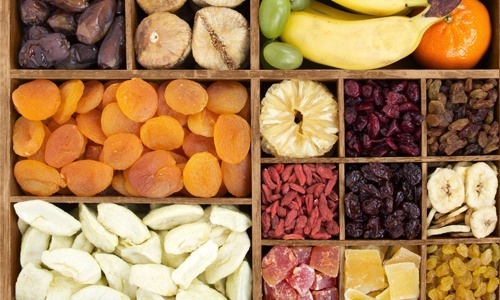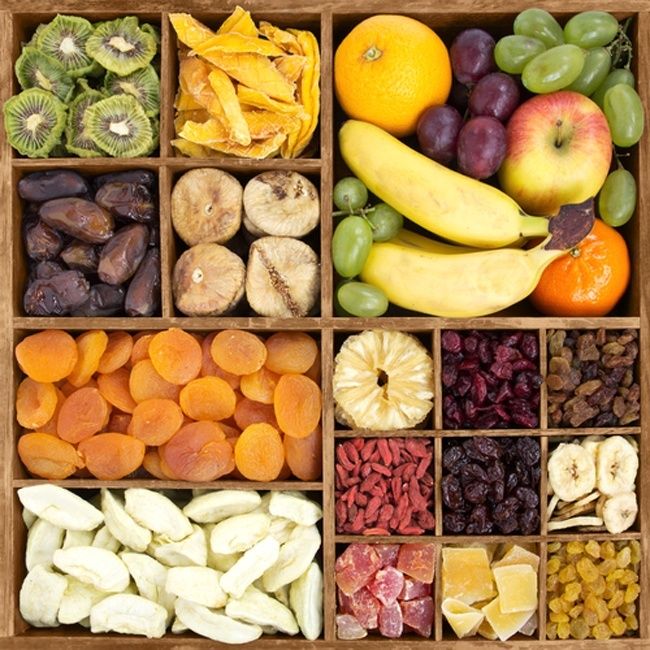

By Adda Bjarnadottir
Information about dried fruit is very conflicting. Some say it is a nutritious, healthy snack, while others claim it is no better than candy.
This is a detailed article about dried fruit and how it can affect your health.
What is Dried Fruit?
Dried fruit has had almost all of the water content removed through drying methods.
The fruit shrinks during this process, leaving a small, energy-dense dried fruit.
Raisins are the most common type, followed by dates, prunes, figs and apricots.
Other varieties of dried fruit are also available, sometimes in candied form (sugar coated). These include mangoes, pineapples, cranberries, bananas and apples.
Dried fruit can be preserved for much longer than fresh fruit and can be a handy snack, particularly on long trips where refrigeration is not available.
Bottom line: Dried fruit has had most of the water content removed. The most common varieties are raisins, dates, prunes, figs and apricots.
Dried Fruit is Loaded With Micronutrients, Fiber and Antioxidants
Dried fruit is highly nutritious.
One piece of dried fruit contains about the same amount of nutrients as the fresh fruit, but condensed in a much smaller package.
By weight, dried fruit contains up to 3.5 times the fiber, vitamins and minerals of fresh fruit.
Therefore, one serving can provide a large percentage of the daily recommended intake of many vitamins and minerals, such as folate (1).
However, there are some exceptions. For example, the vitamin C content is significantly reduced when the fruit is dried (2).
Dried fruit generally contains a lot of fiber and is a great source of antioxidants, especially polyphenols (3).
Polyphenol antioxidants are associated with health benefits such as improved blood flow, better digestive health, decreased oxidative damage and reduced risk of many diseases (4).
Bottom line: Dried fruit is rich in fiber, vitamins and minerals. It is also high in phenolic antioxidants, which have numerous health benefits.
Health Effects of Dried Fruit
Several studies have shown that people who eat dried fruit tend to weigh less and ingest more nutrients, compared to individuals not eating dried fruit (5, 6, 7).
However, these studies were observational in nature, so they can not prove that the dried fruit caused the improvements.
Dried fruit is also a good source of many plant compounds, including powerful antioxidants (8, 9, 10, 11).
Bottom line: Eating dried fruit has been linked to an increased intake of nutrients and a reduced risk of obesity.
Raisins May Reduce the Risk of Certain Diseases
Raisins are dried grapes.
They are packed with fiber, potassium and various health-promoting plant compounds.
They have a low to medium glycemic index value and a low insulin index (12, 13).
This means that raisins should not cause major spikes in blood sugar or insulin levels after meals.
Studies show that eating raisins may (12, 14, 15, 16, 17):
- Lower blood pressure.
- Improve blood sugar control.
- Decrease inflammatory markers and blood cholesterol.
- Lead to increased feeling of fullness.
All of these factors should contribute to a reduced risk of developing type 2 diabetes and heart disease.
Bottom line: Raisins are high in fiber, potassium and other plant compounds. Eating raisins may improve blood sugar control, lower blood pressure and blood cholesterol, as well as, decrease inflammation.
Prunes are Natural Laxatives and May Help Fight Diseases
Prunes are dried plums.
They are highly nutritious, being rich in fiber, potassium, beta-carotene (vitamin A) and vitamin K.
They are known for their natural laxative effects.
This is caused by their high content of fiber and a sugar alcohol called sorbitol, which is found naturally in some fruit.
Eating prunes has been shown to help improve stool frequency and consistency. Prunes are considered to be even more effective at relieving constipation than psyllium, which is another common remedy (18).
As a great source of antioxidants, prunes may inhibit the oxidation of LDL cholesterol and help prevent heart disease and cancer (19, 20).
Prunes are also rich in a mineral called boron, which can help fight osteoporosis (21).
Furthermore, prunes are very filling and should not cause rapid spikes in blood sugar levels (19).
Bottom line: Prunes have a natural laxative effect because of their fiber and sorbitol content. They are also very filling, and may help fight oxidative damage in the body.
Dates May Benefit Pregnancy and Help Prevent Several Diseases
Dates are incredibly sweet. They are a great source of fiber, potassium, iron and several plant compounds.
Of all the dried fruit, they are one of the richest sources of antioxidants, contributing to reduced oxidative damage in the body (3, 22).
Dates have a low glycemic index, which means that eating them should not cause major spikes in blood sugar levels (23).
Date consumption has also been studied in relation to pregnant women and labor.
Eating dates regularly during the last few weeks of pregnancy may help facilitate cervical dilation, as well as, decrease the need for induced labor (24).
One study had women eat dates during the last few weeks of pregnancy. Only four percent of the date-eating women required induced labor, compared to 21 percent of those who did not consume dates (25).
Dates have also shown promising results in animal and test-tube studies as a remedy for infertility in males, but human studies are lacking at this point (22).
Bottom line: Dates are rich in antioxidants, potassium, iron and fiber. Eating dates may help reduce oxidative damage, moderate blood sugar and help with labor in pregnant women.
Dried Fruit is High in Natural Sugar and Calories
Fruit tends to contain significant amounts of natural sugars.
Because the water has been removed from dried fruit, this concentrates all the sugar and calories in a much smaller package.
For this reason, dried fruit is very high in calories and sugar, including both glucose and fructose.
Below are some examples of the natural sugar content of dried fruit (26).
- Raisins: 59 percent
- Dates: 64–66 percent
- Prunes: 38 percent
- Apricots: 53 percent
- Figs: 48 percent
About 22–51 percent of this sugar content is fructose. Eating a lot of fructose may have negative health effects. This includes increased risk of weight gain, type 2 diabetes and heart disease (27).
A small 1-ounce portion of raisins contains 84 calories, almost exclusively from sugar.
Because dried fruit is sweet and energy-dense, it is easy to eat large amounts at a time, which can result in excess sugar and calorie intake.
Bottom line: Dried fruit is relatively high in calories and sugar. Common dried fruits contain 38–66% sugar, and eating too much of them may contribute to weight gain and various health problems.
Avoid Dried Fruit with Added Sugar (Candied Fruit)
To make some dried fruit even more sweet and appealing, they are coated with added sugar or syrup before being dried.
Dried fruit with added sugar are also referred to as “candied” fruit.
Added sugar has repeatedly been shown to have harmful effects on health, increasing the risk of obesity, heart disease and even cancer (28, 29).
To avoid dried fruit that contains added sugar, it is very important to read the ingredients and nutrition information found on the package.
Bottom line: Some fruit is coated with sugar or syrup before being dried. Always read the package when purchasing dried fruit and avoid brands that contain added sugar.
Dried Fruit May Also Contain Sulfites, and May be Contaminated With Fungi and Toxins
Some producers add preservatives called sulfites to their dried fruit.
This makes the dried fruit look more appealing, because it preserves the fruit and prevents discoloration.
This applies mainly to brightly colored fruits, such as apricots and raisins.
Some individuals may be sensitive to sulfites, and may experience stomach cramps, skin rashes and asthma attacks after ingesting them (30, 31). To avoid sulfites, choose dried fruit that is brown or grayish rather than brightly colored (32).
Dried fruit that is improperly stored and handled may also be contaminated with fungi, aflatoxins and other toxic compounds (33, 34, 35).
Bottom line: Sulfites are added to some dried fruit to preserve color, which may cause adverse effects in sensitive individuals. Dried fruit that is improperly stored and handled may also be contaminated with fungi and toxins.
Take Home Message
Same as with many other foods, dried fruit has both good and bad aspects.
Dried fruit can boost your fiber and nutrient intake and supply your body with large amounts of antioxidants.
However, it is also high in sugar and calories, and can cause problems when eaten in excess.
For this reason, dried fruit should only be eaten in small amounts, preferably along with other nutritious foods.
It should not be eaten by the handful, because it is very easy to eat too many calories from dried fruit.
Also, it is a high-carb food, making it unsuitable on a low-carb diet.
At the end of the day, dried fruit is far from perfect, but it is certainly a much healthier and more nutritious snack than chips or other processed junk foods.
This article was reposted from our media associate Authority Nutrition.
YOU MIGHT ALSO LIKE
10 Incredible Health Benefits of a Sugar Detox

 233k
233k  41k
41k  Subscribe
Subscribe 
